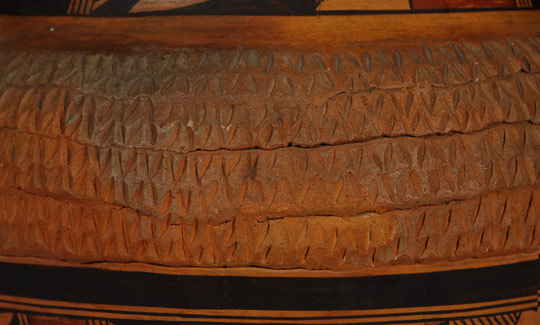Historic Nampeyo Family Polychrome Storage Jar [SOLD]
+ Add to my watchlist Forward to Friend
- Category: Historic
- Origin: Hopi Pueblo, Hopituh Shi-nu-mu
- Medium: clay, pigment
- Size: 12-5/8” tall x 11-5/8” diameter
- Item # C3467 SOLD
Nampeyo of Hano was a very talented potter and one who was versatile in her selection of vessel shapes. This large and tall storage jar was a favored form of hers. I personally know of no other Hopi potter of the period who incorporated the impressions in the clay that appear on the shoulder of the jar. Garnet Pavatea used such indentations in the late 1900s, but none did so as early as Nampeyo.
This jar probably dates to the 1930 decade, a time when Nampeyo was losing her eyesight. Her daughters, Annie and Fannie, often assisted their mom with painting her pottery. Nampeyo was still quite adept at making pottery but unable to paint the designs in that last decade of her life. Around 1930, Annie began suffering from arthritis in her hands. It was probably at that time than her younger sister, Fannie, started painting for her mom. The design on this jar is typical of that painted by Fannie.
It is refreshing to see such a magnificent large storage jar by Nampeyo with designs by Fannie. One is so used to seeing smaller items, particularly bowls, but jars of this scale are not often available. Also, most of Nampeyo’s later works were painted by Annie, but this appears to be the work of Fannie.
Nampeyo was a genius and not the ignorant Squaw1 that most observers of the time thought. She was smart and, with the help of her brother, Tom Polacca, who spoke English, she was an astute business woman. She employed techniques of engineering, mathematics, and art in her work. It was not easy to form those large seed jars for which she is so well known. It took expert techniques to keep the top from falling in and from rim cracks forming from the weight of the top of the jar. She was brilliant at what she was doing and finally, today, is receiving such acknowledgment. Nampeyo was the greatest potter of all in the late 1800s and early 1900s.
Condition: very good condition
Provenance: from a gentleman from California
Recommended Reading: Nampeyo and Her Pottery by Barbara Kramer
1Note: Squaw is an English language loan-word, used as a noun or adjective, whose present meaning is an indigenous woman of North America. It is derived from the eastern Algonquian morpheme meaning 'woman' that appears in numerous Algonquian languages variously spelled. At present, the term is often held to be very offensive. We use it here only to illustrate a term used in the past and we understand and support that it isn't appropriate for use today to describe anyone.

- Category: Historic
- Origin: Hopi Pueblo, Hopituh Shi-nu-mu
- Medium: clay, pigment
- Size: 12-5/8” tall x 11-5/8” diameter
- Item # C3467 SOLD



